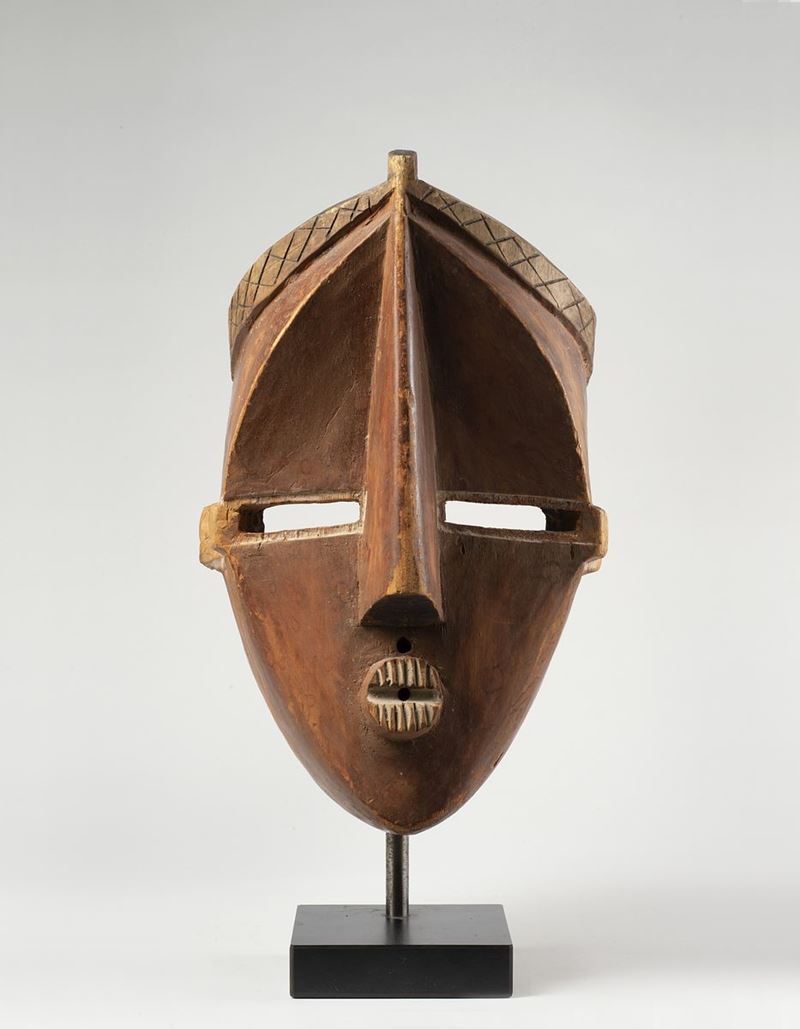Information
H 33 cm
Dance mask.
The face is divided into two parts by its long nose at a dihedral angle, tube-shaped mouth, eyes of rectangular slits, pointed chin, and subtle ears; a form that we would define as pertaining to the “cubist style”.
Provenance
- Former Paolo Morigi collection (Lugano) (Morigi inventory label num. 243);
- Former private collection (Lugano);
Literature
- FELIX MARC LEO & AUTORI VARI “Congo Masks – Masterpieces from Central Africa” Brussels 2018, Edited by Marc Leo Felix, pages 140-145;
- VARIOUS AUTHORS "Face of the Spirits: Masks from the Zaire Basin" Antwerp 1993, pages 97-105;
- Huguette Van Gelewe in FRY JAQUELINE "Twenty-five African Sculptures" National Gallery of Canada, Ottawa 1978, pages 82-87;
- CORNET JOSEPH "Art de l'Afrique noire au pays de fleuve Zaire" Brussels 1972, pag. 183;
- FAGG WILLIAM "Masques d'Afrique dans les Collections du Musée Barbier-Muller" Geneva 1980, pages 132 and 133;
The Lwalwa are a people of almost 20,000 individuals who lived in the triangle formed by the river Kasai and its tributary, the Lueta, in the south-west of the old province of Kasai, on the border with Angola.This small group’s mask belonged to the members of the Ngongo secret society. They were worn during rituals to soothe sacred spirits and increase their success when out hunting. They were also worn during dances organised for funerals and when appointing high-ranking dignitaries. There are male-type and female-type masks, like this one (Mushika).The Lwalwa use a unique system to keep the mask tight to the wearer’s face during dances: they have a small string made of fibres passed through a hole under the nose, blocking it with a knot. The dancer holds the cord tight with their teeth, which keeps the mask close to their face. This is why this group’s masks have no holes around the edges.
(*) Georges Stoecklin (1937-1997). Stoecklin was a dealer of African art based in France in the ‘50s.He was the son-in-law of Roger Bédiat (1897-1956) who, in the ‘20s, relocated to the region of Abidjan to run a coffee plantation in the French colony. At the time, Ivory Coast was still difficult to access, and the brousse became impractical after rainfall. Bédiat became interested in indigenous culture and met Charles Ratton at the Colonial Exhibition in Paris in 1931, where he offered him the chance to collaborate with him as a supplier of tribal works. This is how he found several of the most important masterpieces collected in the region, some of which are exhibited today in museums.
Bibliographic details from: GOY BERTRAND “Cote d’Ivoire - Premieres regards sur la sculpture - 1850 / 1935” Paris 2012, pag. 206(Roger Bédiat) and, Georges Stoecklin, pag. 215;
Contact
Condition report
Suggested lots
Caricamento lotti suggeriti...









